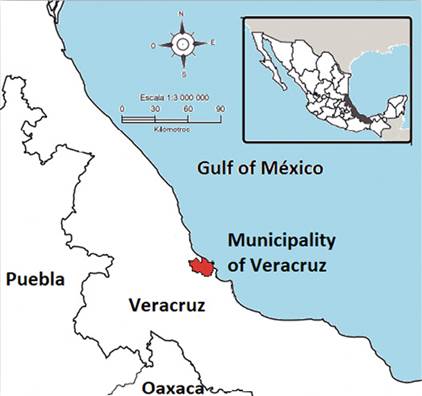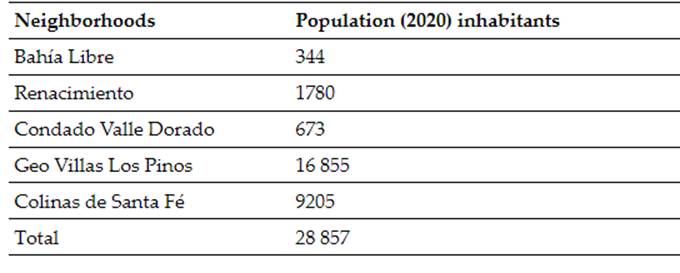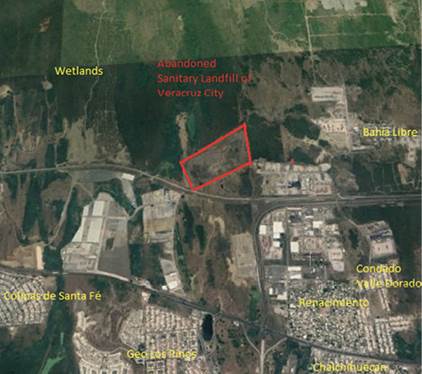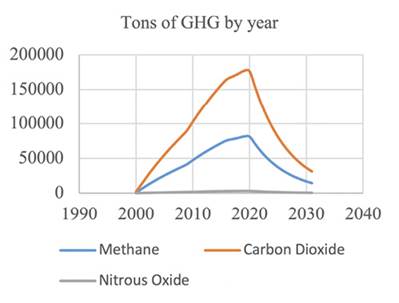I. INTRODUCTION
The Municipal Solid Waste (MSW), are generated in households as result of domestic and some commercial activities, and also the cleaning inside of public spaces as schools, streets, parks and gardens(1). In México according at Ministry of Environment and Natural Resources (SEMARNAT) the waste is composed of their packages and containers of food products, food leftovers, paper, wood, cardboard and a fraction of inorganic materials such as plastic, glass and metals(2). Worldwide almost two thirds of this heterogeneous mixture are biodegradable since they are generally composed of 50 % cellulose, 15 % lignin, 10 % hemicellulose, 5 % protein, starch, pectin and other soluble sugars whose product of anaerobic digestion generates a series of gases called biogas .
The population increase and the change in domestic activities, particularly in developing countries, has caused the generation of large volumes of waste, exceeding the capacity of municipal authorities for its proper disposal(5). According to data and estimates from the World Bank by the year 2020, around 2 010 million tons of MWS were generated on our planet, of which it has been calculated that around 66 % of these are not managed in an environmentally safe manner, expecting that by the year 2050 the global amount of waste increases to 3 400 million tons, with a growth close to 70 %(6).
In Mexico, final disposal sites are classified depending on their operation, depending on the degree of control of municipal solid waste such as Sanitary Landfills, Controlled Disposal Sites and Uncontrolled Disposal Sites, and the technical characteristics can range from complex technological processes to avoid environmental contamination to the complete absence of infrastructure(7). This constitutes a long-term source of contamination, since they impact the environment for years or decades after their closure, abandonment or decommissioning(8).
The final disposal sites of waste they generate and emit biogas(9), which is mainly composed of carbon dioxide (30-45 %), methane (40-65 %) and a variety of gases such as water vapor (1-5 %), hydrogen sulfide (1-3 %), nitrous oxide (1-3 %), ammonia whose emission rate is influenced by factors such as the volume of accumulated waste, organic matter content, moisture, temperature, age of the waste(10), and its stages of operation.
The final waste disposal sites contribute globally with approximately 5 % of the global generation of greenhouse gases (GHG), since these emissions that begin during the operation stages continue for many years after the closure or abandonment of the final disposal site, which represents risks to the environment and to the health of the people who inhabit their environment(9). It has been calculated that in 2020 methane emissions from sanitary landfills and dumpsites in Mexico generated 24.67 Mt CO2 equivalent, being the second country in Latin America with the highest emission rate of this greenhouse gas from landfills(11).
The sanitary landfill of the city of Veracruz, Mexico, began its operations in 2000. It was built using environmental engineering techniques that through the use of cells with membranes, gas venting wells and leachate lagoon, which would have a useful life of 10 years. However continued in use until 2019 when was closed by the Environmental Attorney of the Government of the State of Veracruz, due to the fact that it had collapsed, covering the entire infrastructure with waste and due to frequent fires(13). Therefore, at the end of its operation stage, it was already considered a controlled final disposal site(7).
With Geographic Information Systems (GIS) that use remote sensing techniques(14)the final disposal sites and their facilities have been georeferenced(14)and through spatial data(15)its characteristics (topography and vegetal cover) the foregoing is possible using Google Eart satellite images(16). As Susunaga et al., in 2022 who carried out an investigation using this methodology and determined the characteristics of the uncontrolled final disposal sites of the Sotavento Region in the state of Veracruz, Mexico(13).
Greenhouse gases (GHG) are those that trap heat in the atmosphere and that generate a series of environmental impacts such as global warming and, as a consequence, climate change(7), among these gases are included carbon dioxide, methane and oxide nitrous(11). Methane and carbon dioxide are the two most important greenhouse gases, although the lifetime of both in the atmosphere is different (12 years for CH4 and between 50 and 200 years for CO2), however the difference lies in the warming power and that methane when reacting in the atmosphere becomes CO2 and water, reinforcing the global warming potential through the greenhouse effect(17).
The emission rate of methane, carbon dioxide a nitrous oxide can be determined using the Mexican Biogas 2.0 model(11). Which considers the amount of waste accumulated in a year, and that the composition of the gas is 40% methane and 50 % carbon dioxide and assuming that six months after the closure of the site the maximum generation occurs, which decreases as the organic matter is consumed and what occurs one year after the abandonment or closure of the final disposal site(18), and a 1.5 % of emission as nitrous oxide.
The inadequate disposal of Municipal Solid Waste in the uncontrolled abandoned final disposal sites represents an important source of contamination for the surrounding in-habitants, since remediation techniques, waste isolation or monitoring of the same are not generally included(12) (13), the aim of this work was to determine the generation rate of methane and carbon dioxide, which are the greenhouse gases with the highest proportion of biogas from the abandoned disposal site of the City of Veracruz, Mexico in order to demonstrate the importance of the adequate closure of the site to minimize the emission of greenhouse gases and their potential impact on the environment.
II. MATERIAL AND METHODS
A. Abandoned Solid Waste Final Disposal Site of the City of Veracruz, Mexico.
The municipality of Veracruz is located in the central part of the State of Veracruz (figure 1), in the Sotavento Region on the coast of the Gulf of Mexico, it has 297 km2 (0.3% of the state territory) and 607 209 inhabitants which represents 7.5 % of the state total and with the municipalities of Boca del Río, Medellín and Alvarado form as a whole the most metropolitan area in the state populated metropolitan area in the State of Veracruz with 939 046 inhabitants(19)(Fig. 1).
According to the data provided by the National Institute of Statistics and Geography (INEGI), the climate in the municipality of Veracruz is type A (w2) Warm Subhumid with summer rains, with prevailing winds from the North with a speed of 2 m/sec., average temperature of 29°C and relative humidity of 75 %(19).
The Abandoned Sanitary Landfill of the city of Veracruz, was an infrastructure for the disposal of Municipal Solid Waste, closed since December 2019 by the environmental authorities of the Government of the State of Veracruz and which is located north of the municipality of Veracruz(20)in a property in commodatum of the Ex Hacienda Santa Fe of The Administration of the Veracruz National Port System (ASIPONA) at 19°13’56.98”N and 96°1 3’22.11”W (Fig. 2). In a radius of 2 kilometers, borders to the north and west with a wetland area, to the east with to the east with logistics zones and the Renacimiento, Bahía Libre and Condado Valle Dorado neighborhoods, to the southeast with the Chalchihuecan neighborhood, and to south with the Olmeca Industrial Park, and the Geovillas Los Pinos and Colinas de Santa Fe neighborhoods with a population in 2020 of 28 857 inhabitants(19), as shown inTable 1.
B. Characteristics of the Abandoned Final Disposal Site of the City of Veracruz, Mexico using GIS tools.
The characterization of the abandoned final disposal site, their coverage area and some topographic features was carried out through of Geographic Information Systems through analysis of satellite images with the use of remote sensing techniques(14)using free-form satellite photographs from Google Earth (using available photographs from the years 2002, 2013 and 2023) with a multi-criteria decision analysis (MCDA) approach (which is an analytical technique that allows the identification of various solutions to a problem, mainly using cartographic variables as starting data.)(16), and using data available in the literature
C. Calculation of accumulated waste the Abandoned Final Disposal Site
The volume of the abandoned disposal site was determined using the formula proposed by Susunaga et al. in 2022(13), multiplying the area determined with the satellite photographs using Google Earth with the average height that occurs in the abandoned sanitary with, the following formula (Eq.1) we used.
Where A is the total area of Abandoned Landfill, AH is the average height of the waste resulted from tracking the cover layers using Google Earth, and to calculate the accumulated tons of waste, the average value of the established volumetric weight of 1 300 kg/m3 we used for compacted waste in Sanitary Landfills and controlled final disposal sites(13).
D. Calculation of the volume of methane, carbon dioxide and nitrous oxide based on the biogas generated in the abandoned disposal site by Mexican Model of Biogas 2.0.
For the estimation of the generation of methane and carbon dioxide from the Final Disposal Site, the equations proposed in the Mexican Biogas Model 2.0 will be used, which establishes that 40 % of the biogas produced corresponds to methane and the remaining 50 % corresponds to carbon dioxide and 3 % to nitrous oxide(11). This method was selected since it is a calculation mechanism approved by the Mexican government in the standard NOM-083-SEMARNAT-2003 and in the project to modify the official Mexican standard NOM-083-SEMARNAT-2003 , which uses a first-order degradation equation which is described in Eq.2.
Where QLFG is the maximum biogas flow expected (m3y-1), i is the increase in time of 1 year (y), n is the total time of disposal of the MSW (y), k is the rate of methane generation (y-1), L0 is the potential generation of methane (m3t-1), Mi is the mass of waste disposed of in year i, tij is the age j of the mass of waste Mi disposed of in year i (y), MCF is the methane correction factor, and F is the fire adjustment factor.
The values for the methane generation index (k) for the Mexican model of Biogas version 2.0 depend on the time it takes for the waste to degrade, the which can be: DDR Very rapid waste degradation. DRMR, degradation moderately fast waste, DRML, waste degradation moderately slow and DRL waste degradation very slow(11)described in Eq.3.
Where % ri is the percentage of waste in each category, vp is the value of k predetermined by the Mexican Biogas Model Version 2.0 in each of the degradation categories (11).
The Methane Generation Potential (L0) is defined as the potentially produced amount of methane (CH4) per unit mass of waste when it degrades, which depends exclusively on them(11) Eq.4.
Where MCF is the correction factor for methane, DOC us the fraction of degradable organic carbon, DOCF is the fraction of assimilated degradable organic carbon (theoretically 0.77), F is the fraction of methane in Biogas (assumed 0.5) and 16/12 is a stoichiometric constant(11).
The Degradable Organic Carbon (DOC) content can be calculated by equation 4, this depends on the composition of the waste and varies with the final disposal site, which is obtained by the Eq.5 (11).
A corresponds to the percentages of paper, cardboard and textiles, B is the percentage of garden waste from public parks and gardens, C is the percentage of residues that corresponds to food remains and D is the percentage of residues that corresponds to wood and straw(11).
The Correction Factor for Methane (MFC) is the adjustment of the estimate of Methane generation for the model that considers the anaerobic degradation of the waste and depends on the depth of the final disposal sites and their management practices, for Final Disposal Sites with waste management and a depth greater than 5 meters, the value of the correction is 1(6).
The value of the Fire Adjustment Factor (F) considers that when a fire occurs at disposal sites in the end, the residues are consumed as fuel, producing ash which do not contribute to the generation of biogas, in case this occurs phenomenon, the percentage of the area must be deducted from the biogas generation impacted by multiplying by the adjustment given the severity of the fire impact (1/3 for low impact, 2/3 for medium impact, and 1 for severe impact)(11).
E. Calculation of the tons of methane and nitrous oxide in tons of CO 2 equivalent.
To calculate the tons of methane and nitrous oxide equivalent to tons of carbon dioxide, the formulas proposed by the Institute of Ecology and Climate Change of Mexico in 2020 were used(21) (22), which establishes (Eq.6):
Were CH4em is the total methane emissions during the reporting year and PCGCH4is a Global warming potential of methane.
Were N2O em (Eq.7) is the total nitrous oxide emissions during the reporting year and PCGN2O is a Global warming potential of nitrous oxide.
III. RESULTS AND DISCUSSION
The Abandoned Sanitary Landfill of the City of Veracruz was designed, built and operated in accordance with the Official Mexican Standard NOM-083-ECOL-1996, (which was repealed in 2003 and modified to NOM-083-SEMARNAT-2003) that established the conditions that sites destined for the final disposal of municipal solid waste must meet(7). It began its operation in the year 2000 (13) (20), based on the analysis of satellite images from Google Earth of the years 2002 (Figure 3), 2007 and 2012 was possible to determine that there were six cells for the deposit of waste with a total area of 119 900 m2 as shown in (Table 2), which were built using geomembrane with the trench method with an approximate depth of two meters.
Table II Year and Area of Construction of the Cells of the Abandoned Sanitary Landfill in the City Of Veracruz

At the beginning of its operation, the abandoned sanitary landfill had three disposal cells (cell 1, cell 2, cell 3), which finally in 2006 joined into a single macro cell, after which cell 4 was built in the same year and cell 5 in 2013 (figure 3).
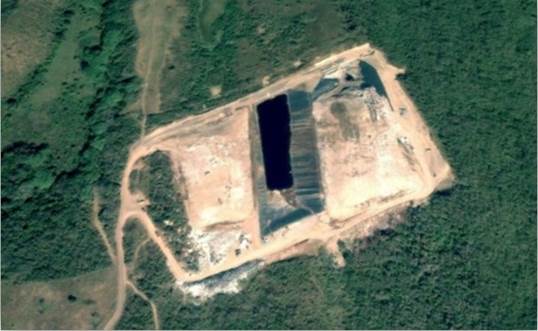
Fig. 3 Abandoned Landfill of Municipality of Veracruz, Veracruz State, Mexico in the year 2002, with cell 1 and cell 2 closed and cell 3 in use.
The Abandoned Landfill in the city of Veracruz was designed for a useful life of 10 years. However, it continued in operation until it collapsed and all the existing infrastructure (biogas wells, leachate lagoon, etc.) was covered with waste, so its final area is 167 228 m²(13). And in accordance with the NOM-083-SEMARNAT-2003 can be considered as a Controlled Final Disposal Site(7).
According to the documentary information obtained between 2008 and 2015, the municipality of Boca del Río disposed of its waste in the Abandoned Sanitary Landfill of the City of Veracruz (Table 3). The above due to the closure of the municipal dumpsite in 2010 and in the 2015 the waste from that municipality began to be deposited in the El Guayabo Landfill in Medellín de Bravo, Veracruz(13).
Table III Daily Tons of Municipal Solid Waste Disposed in Veracruz City Abandoned Landfill, Veracruz, Mexico(13)

The results ofTable 3show a significant increase in the generation of waste from the municipalities of Boca del Río and Veracruz that were disposed of in the Abandoned Sanitary Landfill of the City of Veracruz. The above due to the fact that it is the metropolitan area with the highest population growth(19), with rapid urbanization that is counting on high economic progress and standard of living.
Using the data fromTable 3, it was possible to determine the total amount of waste disposed of in the Abandoned Sanitary Landfill of the City of Veracruz (Table 4) by the municipalities of Veracruz (2000-2019) and by the municipality of Boca del Río (2008-2015) in order to use these data in the Mexican Biogas 2.0 model.
Table IV Disposal of Waste in the Abandoned Landfill of the City of Veracruz Between the Years 2000 and 2019

Comparing the tons of waste disposed of in the Abandoned Landfill of the City of Veracruz calculated inTable 4at 4 542 812 tons does not coincide with what Susunaga et al. proposed in 2022(13)(1 956 567 tons). A 57 % reduction can be seen, this is due to the degradation of organic matter, the presence of fires that consume waste and especially the generation of biogas(4).
By using layers of different heights determined from the Google Earth image of August 5, 2023, it can be seen that the shape of the abandoned landfill is like a truncated pyramid, three zones of different heights can be identified (Figure 4).
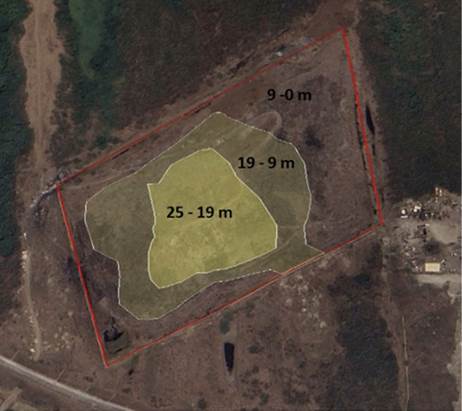
Fig. 4 Level layers of Abandoned Landfill of Municipality of Veracruz, Veracruz State, Mexico in the year 2023.
The highest height that occurs in the abandoned sanitary landfill of the city of Veracruz is 25 meters from the base of the waste pile, so the average height can be established at 12.5 meters. Using the proposed formula number 5, it is determined that the volume of stored waste is 1 505 052 m³ which is equal to that proposed by Susunaga et al. in 2022(13).
To determine the weighted methane generation index (k) was based on the Basic Diagnosis for the Integral Management of Waste of the Ministry of the Environment and Natural Resources of the Government of Mexico for the year 2021 for the state of Veracruz(3)and the values of k Mexican Biogas Model Version 2.0 for the Southeast Region and Sotavento Region in Veracruz State, tabulated as presented by Susunaga-Miranda in her PhD thesis in Environmental Sciences in 2023 (Table 5) (23).
The MCF Methane correction factor for the Abandoned Sanitary Landfill of the City of Veracruz, which had waste management with a medium height of 12.5 m has a value of 1.0 and the potential for methane generation L0is 54.5 m³/Ton and the correction value for fires F given the severity of the constant fires that occurred will have a value of 1(24).
The Abandoned Sanitary Landfill of the Municipality of Veracruz has the highest MCF factor that is comparable to other cities coasts such as Acapulco in the state of Guerreo(25), while the methane generation potential (L0) is lower from what was proposed for the southeast region proposed by the same model.
With the generation and disposal of waste in the Abandoned Sanitary Landfill of the City of Veracruz calculated and tabulated inTable 4was calculating the Biogas generation from the year 2000 and up to 2031 using the Mexican Biogas 2.0 Model in an excel sheet (Table 6).
Table VI. Calculation of the Biogas Generation at Veracruz City Abandoned Landfill Between Years 2000 and 2031
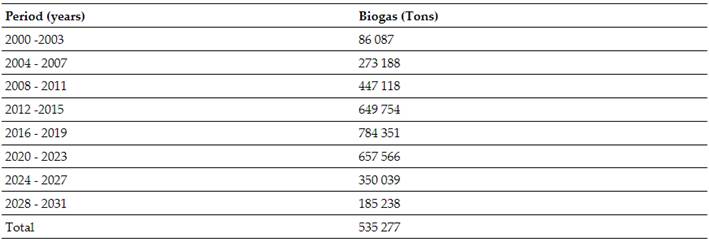
As can be seen inTable 6, the highest rate of Biogas emissions occurred during the operation stage of the Sanitary Landfill, since it is at this time when the greatest waste degradation occurs. The emissions decrease from the year 2019 after the closure of the site although the Biogas emission can continue for more than 50 years(4). In this work it has only been calculated until the year 2031, for when it is calculated that the total emission of biogases is of 535 277 tons.
With the data obtained from theTable 6, the generation of tons of greenhouse gases (CO2, CH4and NO) is calculated from the year 2000 and up to 2031 (Table 7)
Table VII Calculation of the Ghg Generation at Veracruz City Abandoned Landfill Between Years 2000 and 2031
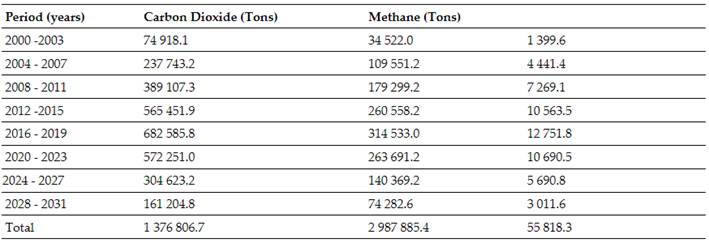
The generation of GHG were plotted according to the results obtained atTable 7(Figure 5) for the years 2000 to 2031, although the generation continues for more than 50 years, due to persistent degradation of de organic fraction of waste(26). However, the Mexican Biogas Model does not establish a change in the composition of biogas, which does occur given that previous studies have shown that methane can represent up to 65 % of emissions and that over time this fraction will diminishing to almost disappearing(27).
If the graph ofFigure 5is compared with those obtained for the Final Disposal Sites of the Sotavento Region such as the abandoned dumpsite of El Guayabo reported by Susunaga in 2022(23). It can be seen that in the case of the Abandoned Sanitary Landfill of the City of Veracruz there are two turning points due to the increase in generation caused by the disposal of waste from the municipality of Boca de Río from 2008 to 2015.
Finally, with equations 6 and 7 considering the global warming potential for methane at 28 and for nitrous oxide at 265, the equivalent tons of CO2are calculated(21)(Table 8).
Table VIII Calculation of the co2 tons eq generation at veracruz city abandoned landfill between years 2000 and 2031
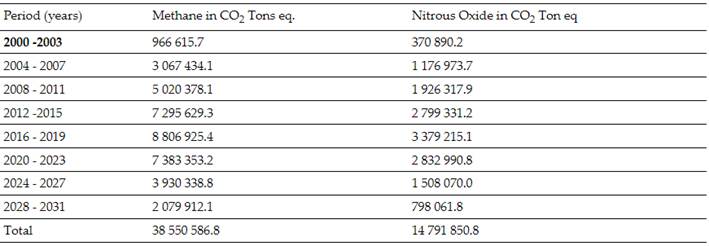
As can be seen inTable 8, the value of the equivalent Tons of CO2emitted by the Abandoned Final Disposal Site of the City of Veracruz, due to the emission of methane and nitrous oxide, is much higher than that of carbon dioxide itself. Generated as biogas, this affects the deposit of these gases in the atmosphere causing global warming that affects the climate and coastal ecosystems of which the City of Veracruz is a part(28).
With the data obtained inTables 7and 8, it can be established that the emission of greenhouse gases until 2023 is 47 548 112 Tons of CO2equivalent. Which translates into a significant contribution to climate change and the urban heat island due to what by 2030 the temperature of the Metropolitan Zone of the City of Veracruz will increase according to studies of the Universidad Veracruzana in 0.6°C(29).
IV. CONCLUSION
Due to the abandonment of the Sanitary Landfill of the City of Veracruz, given an administrative closure by the state environmental authorities, thousands of tons of waste have been deposited without having a mechanism to control biogas emissions resulting from their decomposition. Which causes the generation of Greenhouse Gases that are emitted directly into the atmosphere.
Biogas contributes significantly to the emission of greenhouse gases, however, a series of gases with lower concentrations but with high global warming potential are also emitted also they contribute to a greater extent to climate change, because they have a higher calorific value than carbon dioxide itself.
An abandoned disposal site and to which none of the closure procedures established in the national regulations have been carried out, is a constant source of biogas emission that contributes to the increase in the concentration of greenhouse gases that contributes to climate global change, since the degradation of the organic matter present in the accumulated waste continues for more than 100 years.
The Abandoned Sanitary Landfill of the City of Veracruz contributes to a great extent to climate change due to the generation of greenhouse gases, since it has been shown that due to the increase in the amount of CO2in the local atmosphere due to the emission of methane and dioxide nitrous and given the proximity to the reef area on the coast of the Gulf of Mexico, contributes to the rise in sea temperature and with it to the bleaching of corals in the Veracruz Reef System National Park due to global warming. Likewise this Disposal Site final Uncontrolled abandoned is a participant in the increase in temperature in the metropolitan area of the City of Veracruz, forming what is known as an urban heat island.
It is important that the Federal, State and Municipal authorities contribute to the closure and cleanup of the Abandoned Landfill of the City of Veracruz, since it represents a source of contamination and an environmental liability, that by law are obliged to repair the damage through the techniques established in the Mexican regulations, to minimize the impact of this site due to the generation of greenhouse gases.














